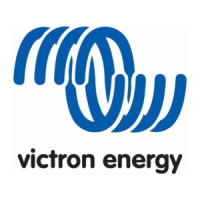
Do you have a question about the Victron energy EasySolar-II GX 24/3000/70-32 and is the answer not in the manual?
| Model | EasySolar-II GX 24/3000/70-32 |
|---|---|
| Category | UPS |
| Inverter Type | Pure sine wave |
| Rated Power | 3000 VA |
| Peak Power | 6000 W |
| Input Voltage | 230 VAC |
| Output Voltage | 230 VAC |
| Battery Charger Output Current | 70 A |
| Maximum PV Array Open Circuit Voltage | 150 V |
| GX Device | Yes |
| Maximum AC Input Current | 32 A |
| Continuous Output Power | 2400W |
| Battery Voltage | 24V |
| PV Charge Controller | MPPT |
| Protection | Overload, short circuit, over temperature, reverse polarity |
| Communication | VE.Direct, Wi-Fi |
Provides an overview of the Victron MultiPlus-II GX's integrated components and functions.
Information on accessing the latest version of the manual via link or QR code.
Critical safety information regarding electrical shock, handling, and general precautions.
Guidelines for safely transporting and storing the product, including environmental conditions.
Instructions for safe electrical installation, grounding, wiring, and environmental considerations.
Details features common to all applications, such as the GX LCD display and PowerAssist.
Discusses how the product provides backup power during grid failures using batteries.
Describes how to manage AC power to prioritize charging based on available current.
Explains how the product supplements limited AC sources with battery power.
Covers the built-in battery monitor for generator start/stop functions.
Describes how the product ensures autonomous power during grid failures.
Details the adaptive 4-stage charge algorithm, BatterySafe mode, and Storage mode for lead-acid batteries.
Explains ESS configuration for grid feedback and reactive power control modes.
Describes the three-position switch for operation modes (Off, On, Charger Only).
Explains how the GX card behaves when the product is switched on/off or enters an alarm state.
Lists the system parameters and information shown on the GX display.
Explains how error codes are displayed and where to find more information.
Shows a diagram of the unit with labeled connection points.
Provides guidelines for selecting a suitable installation location, considering ventilation and temperature.
Details requirements for battery capacity and cable cross-sections, and the connection procedure.
Step-by-step instructions for connecting battery cables, including safety warnings.
Instructions for connecting AC input and output cables, with safety precautions.
Describes methods for remotely controlling the product using an external switch or panel.
Explains the programmable relay's use, e.g., for generator start/stop.
Outlines requirements for connecting multiple units in parallel.
Explains how to configure the product for three-phase operation.
Lists standard factory settings suitable for single-unit operation.
Provides brief explanations for various configuration settings.
Explains output frequency setting and adjustability.
Details the accepted input voltage range and synchronization.
Describes the AES feature for reducing no-load power consumption.
Recommends settings for various battery types and charging adjustments.
Describes the equalisation mode for traction batteries.
Lists current limit settings for PowerControl and PowerAssist.
Describes the WeakAC setting for handling distorted input voltage and current.
Describes the AC-out-2 for non-critical loads.
Details the use of VEConfigure software for product configuration.
Provides guidance on product maintenance, focusing on connection checks and cleanliness.
Lists common problems, their causes, and solutions for troubleshooting.
Explains how VE.Bus error codes are displayed and directs to documentation.
Presents detailed technical specifications for different models of the product.
Provides a detailed overview of all connection points on the device.
Shows a block diagram illustrating the internal connections and functionality.
Illustrates how to connect multiple units in parallel.
Shows diagrams for setting up three-phase systems.
Explains the 4-stage charging process (Bulk, Absorption, Float, Storage).
Shows a graph illustrating temperature compensation for charging voltages.
Provides dimensional drawings and specifications of the product.